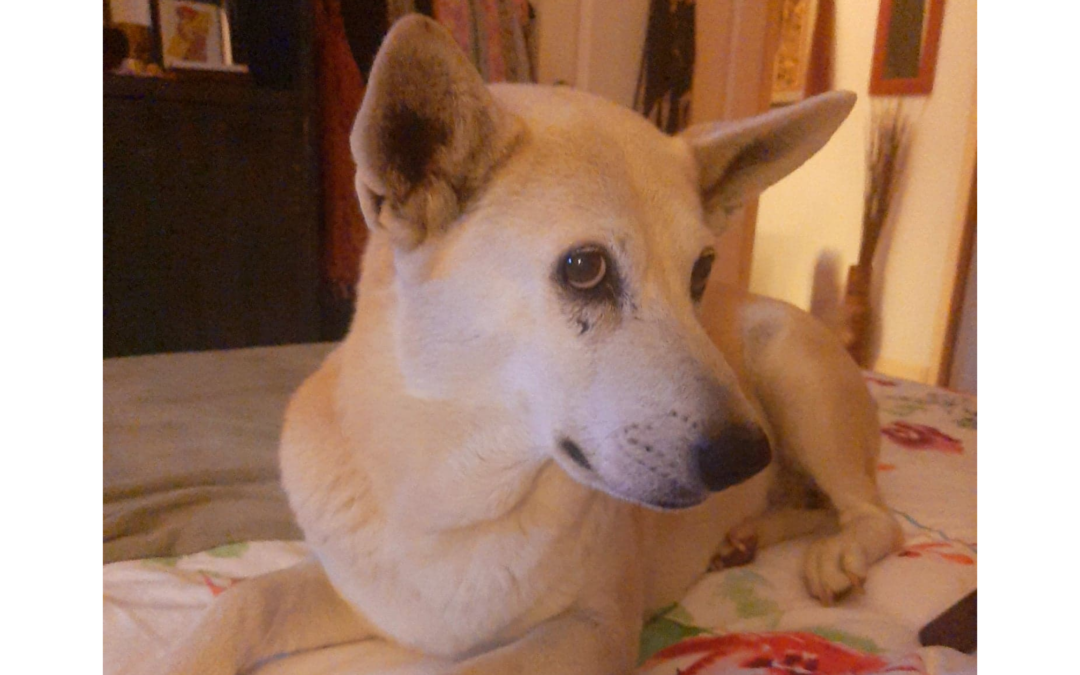If she knew I was writing this, she’d be quite unhappy with me but it needs to be said, Jackie Chan is getting older and becoming incontinent. This is a first for me with a female dog, and so I’m looking to experts in our treatment path. There may be something we can try, naturally if possible, as we need to be careful with her liver condition.
Now when I tell my friends they say she needs diapers, we look at each and kind of crack up because putting diapers on JC would be like wrestling an alligator. I like my hands and would like to keep them, along with all my digits – trying to keep my sense of humor! She is tough though and still plenty active, and keeping her dignity through it all.

So, I’ve just sent a message off to our local vet, Dr. Top. Most likely we’ll do a urinalysis and go from there. In the mean time, I’ve been researching a bit and thought I’d drop this article here in case anyone reading has a female dog with a similar issue.
Once I have word on what’s going on, and how to treat her, I’ll touch base later with a follow up in Ask Dr. Top. Watch this space, and for now read below on what might be causing uncontrolled urination in your female dog.
What Is Urinary Incontinence?
Urinary incontinence is a fairly common problem in spayed female dogs as they age. Quite often, your dog will be unaware that she’s leaking urine, though you may be very aware of it when it happens inside your home. The good news is that your veterinarian may be able to prescribe a medication to help
Urinary incontinence refers to unintentional leakage of urine by housetrained dogs. This is fairly common; it can affect up to 20% of spayed female dogs; especially as they get older. Sometimes urinary leaking involves just a few drops of fluid; at other times, it can involve unintentional urination of quite a lot of fluid. Urinary incontinence is not intentional and it isn’t susceptible to self-control; as a result, it can’t be treated through behavioral training.
While urinary incontinence isn’t harmful in itself, if left untreated it can lead to skin conditions or, in some cases, to more serious kidney or bladder infections.
Symptoms
The most obvious symptom of urinary incontinence is, of course, unusual voiding of urine inside the house (when the dog is fully house trained). In addition, the following symptoms may occur:
- Irritated skin
- Unpleasant odor
- Unusual licking of the vulva area
- Urinary dribbling
Causes
There are a variety of potential causes for urine leakage, including infections, neurological disease, kidney disease or other diseases that cause increased consumption of water, senility, ectopic ureters, stones, tumors and urethral sphincter induced incontinence (USMI) in female dogs. The most common cause of incontinence in middle-aged or senior spayed female dogs. The cause is thought to be multifactorial with links to lack of estrogen from being spayed, increased size of a dog and even obesity. This is known as urethral sphincter mechanism incontinence.
This type of incontinence is related to the hormone estrogen. Estrogen strengthens the dog’s muscles which control urination. When the hormone levels become lower with age, her muscles no longer hold urine in the right place. As urine collects in the vestibule area, it can then leak out when she moves and most commonly occurs when she gets up or lies down.
In most cases, urinary incontinence is the only problem, though sometimes a urinary tract infection or other disease is seen as well which makes screening a urine in these dog’s very important. Sometimes your veterinarian may want to screen bloodwork or imaging diagnostics such as x-ray as well.
Treatment
If your spayed female dog has problems with urine leakage, such as a pool of urine left on her bed after sleeping, the first step is to see your vet. She will likely recommend a urinalysis and bloodwork to rule out a urinary tract infection or other diseases such as diabetes or kidney disease.
If other causes for urinary incontinence are ruled out and your pet is diagnosed with USMI, than your vet may recommend a medication called Proin which contains phenylpropanolamine (PPA). At the time of this writing, this medication is the most common drug used to treat hormonal incontinence in spayed female dogs. It is tolerated well by majority of dogs, though discuss with your vet if it is appropriate for your pet. This medication helps increase the smooth muscle tone of the bladder and urethra to help control the flow of urine. This medication does not work right away but rather takes a few days to weeks to become effective.
Another drug called Incurin which is hormone based has also been used for treatment in USMI. This drug is also labeled only for hormone-responsive incontinence in female dogs. According to the FDA, estrogens increase the resting muscle tone of the urethra in females and can be used to treat female dogs with urinary incontinence due to estrogen depletion. The most common side effects associated with Incurin treatment included a loss of appetite and vomiting.
If hormonal incontinence is diagnosed, your veterinarian can help determine the best treatment to help manage this condition for your dog.
Prevention
The cause of hormonal incontinence is mutifactorial in dogs but has been linked to spaying, obesity and increased size of pet. Most veterinarians agree that avoiding spaying your pet is not reliable or recommended as majority of spayed female dog’s live a very happy and comfortable life. In addition, they do not have to deal with the risks of pregnancy, mammary cancer, pyometra and more.
With urinary incontinence, the best option is to keep a close lookout for the problem and to address it quickly. By nipping the problem in its earliest stages, it’s easier to avoid any skin or bladder issues (and, of course, it’s easier to keep your home urine-free). In addition, as urinary incontinence can be a symptom of a more serious issue, it’s important to have a vet address the problem as early as possible.
If you suspect your pet is sick, call your vet immediately. For health-related questions, always consult your veterinarian, as they have examined your pet, know the pet’s health history, and can make the best recommendations for your pet.
~ Staff Writer, The Spruce Pets


Recent Comments